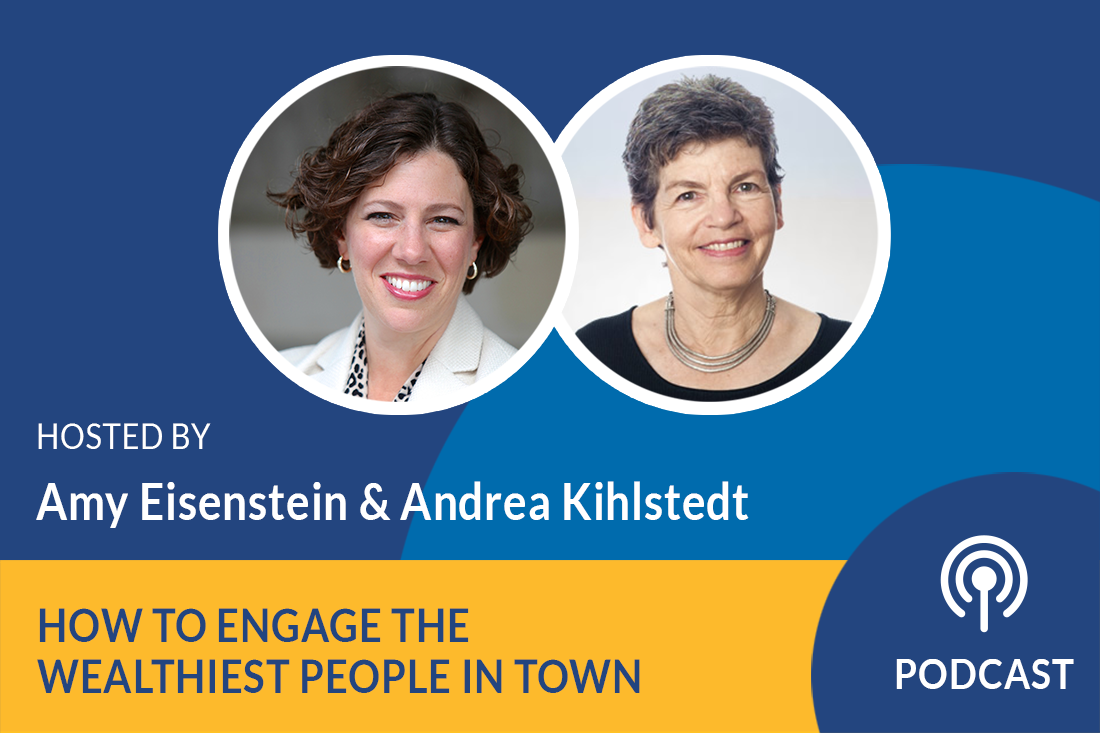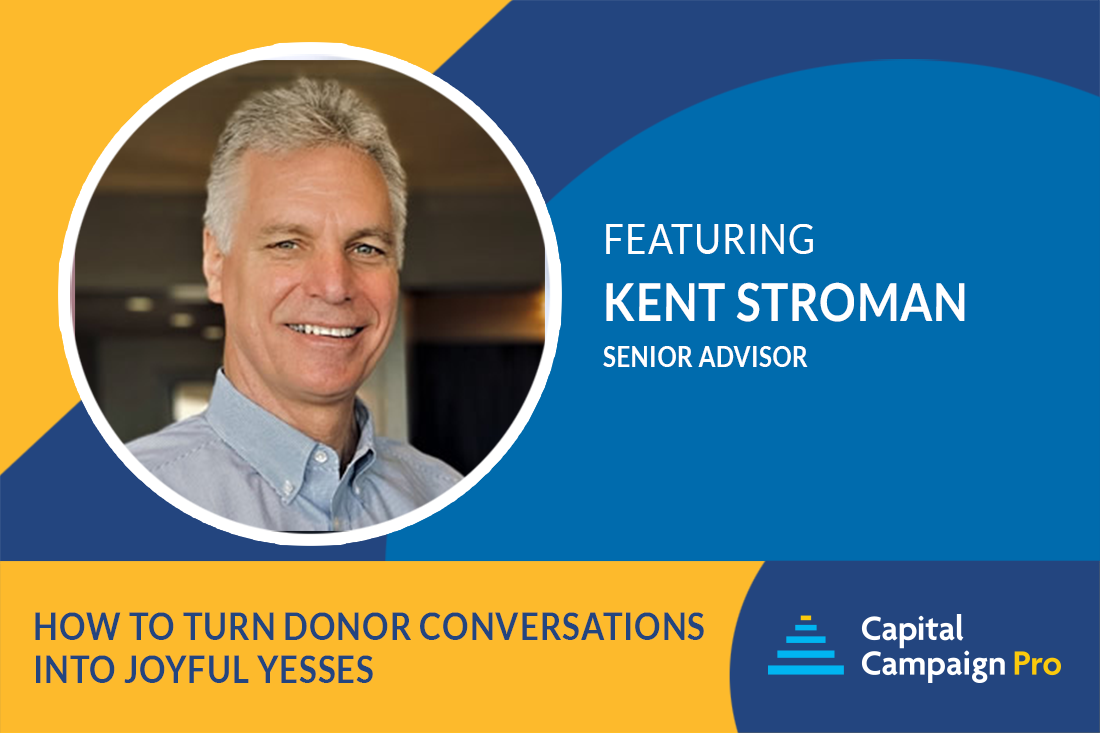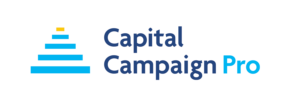Podcast: How to Engage the Wealthiest People in Town

Season 3, Episode 55
In this episode, Amy Eisenstein and Andrea Kihlstedt provide more insight into engaging the wealthiest people in town for your campaign. Listen to learn how to identify, research, and cultivate them for your capital campaign.
Listen Now:
Amy Eisenstein:
It may come as a surprise to you that not all wealthy people drive Rolls-Royces. In other words, they may not be able to be spotted on the road. So today’s topic is all about how to find and engage the wealthiest people in your community. Let’s get started.
Hi, I’m Amy Eisenstein. I’m here with my colleague and co-founder, Andrea Kihlstedt, and today we are super excited to talk to you about how to identify and engage the wealthiest people in your community for your campaign. Andrea, get us going.
Andrea Kihlstedt:
Yes, thank you, Amy. This is such a great topic.
I think there are many, many organizations that don’t feel like they have a direct line or access to the people with real wealth in their community. And what’s more, they’re intimidated by the very idea of trying to get to know those people. They feel like they’re sort of outclassed or those people won’t want to talk to them. And so as a result, they back away. They put themselves and their organizations in a different social class and they often miss huge opportunities.
So I think it’s important that we talk about it. We talk about how to find those people, who are they really looking form how to find them and how to draw them in, how to get to know them.
Amy Eisenstein:
I think that’s really important because it’s not just about identifying them — it’s about really how to engage them authentically so that they will want to get involved in your organization. And most donors don’t simply want to be approached as an ATM. We talk about this idea that you’re just going to them for money.
So the question is how to engage them in terms of what other value they bring to your organization and how to get them really involved and to care about your cause and your mission so that they are happy and delighted to contribute and support. So how should an organization think about approaching some of the wealthiest people in their town?
Where to Find the Wealthiest Donors in Your Community
Andrea Kihlstedt:
Well, first Amy, let’s talk about who they’re looking for, who they really are looking for. So it’s one thing to assume that the people you’re looking for are all at the country club and on the golf course. Of course, there may be some people that you’re looking for there, but there’s a very good chance that there are a number of people who are very generous in your community, who really give money generously to projects, who are not country club people — who are just members of your community. And how would you go about trying to identify people like that, Amy?
Amy Eisenstein:
Yeah, so we were having this discussion the other day and we were talking about this book that came out might be 20 years now, The Millionaire Next Door. And so a lot of people can’t be identified, as you say, on the golf course, in the country club, in a Rolls Royce. Some of the wealthiest people that I ever worked with at a university, they drove the oldest station wagon you’ve ever seen. They had no interest in material things. They were all about giving back.
So where could we find them? We could find their name on the donor walls of every institution in town.
They were at the top of the hospital donor wall. They were on university buildings. They were on the theater donor wall, and they love to go to the theater and support the arts. They chaired the hospital campaigns. They were active and involved, but if you were looking for a Rolls-Royce, that was certainly nowhere to be found.
So the question is how to look for the right clues. What boards are they sitting on? Who’s sitting on the boards of organizations in your community? Who are on the donor walls?
Andrea Kihlstedt:
So good place to start is actually take your little iPhone and it’s so simple to do this now and go into the major institutions in your community and take pictures of the donor walls, particularly the current donor walls. Just snap a picture. Nobody’s going to stop you. Nobody’s going to come running over and say, “Don’t do that.”
And then when you actually print out the pictures and you start looking at the names, you’re going to start to see that there are some names that recur again and again in the upper levels of giving. Maybe not the top levels, but the top two or three levels. Look for the people whose names occur again and again.
Look in your symphony program or look in your theater program or, as Amy said, look on the hospital wall or if there’s a community college or you have a college in your town. Go and look at the names on the walls in the college center. Just start to notice what names come up again and again. And if you start to look carefully, you can probably identify 10 names, let’s say, of people who just are generous. They clearly both have money and they’re generous. Those are two good characteristics to start with.
Discover the Interests of the Wealthiest Donors in Your Community
Then the next characteristic is what kinds of things are they interested in? How would you begin that task, Amy?
Amy Eisenstein:
Well, I think if they’re consistently giving to the arts, to multiple arts organizations, that’s an indicator. If they’re giving or volunteering with several animal shelters in town, that’s an indicator, or healthcare, right?
Many people do have pet projects and favorite charities, and you may start to notice a pattern. I would also talk to other people on your committee and in your network and try and branch out your network to whatever degree you can and look on LinkedIn, look on social media, look on Facebook. Do they post? I mean, some people will and some people don’t.
There is a trail of clues if you look for it. I mean, certainly you can start with a very basic Google search, but I would look to see what they’re sharing, what they’re talking about. And sometimes you’ll have luck in this area and other times you won’t, but it’s a good place to start.
Andrea Kihlstedt:
Yeah, I mean, you have to be fueled by curiosity. It really helps to be naturally curious about people and to try to find out what makes them tick. I mean, to me, it’s always been fascinating to try to figure that out. And once you have an… Let’s say you have a list of 10 people, then make each one of them a little research project. Say, okay:
- How much can I find out about these people?
- What do they like?
- What do they give to?
- Do they have kids?
- Are they retired?
- Do they take vacations and go places?
Amy Eisenstein:
Who do they know?
Andrea Kihlstedt:
Do they volunteer? Who do they know?
Amy Eisenstein:
Who are they linked to?
Andrea Kihlstedt:
Who are they linked to?
I mean, it’s amazing when you start getting curious how much there is there is to find out. And at some point in that process, you’re going to find that you have a connection, that your organization has a connection to some of them.
Now, some of them you may have no connection to at all. It’s fine, let them go. But the ones where you do have a connection, either you know somebody who knows them, they have a history of giving to organizations with an overlap to the mission of your organization, those are the people you want to take to the next step, right?
Alright, now let’s get to know them.
Amy Eisenstein:
Well, one thing that we didn’t say yet that I think is the most obvious probably, hopefully everybody already did this, but look in your database to see if they’ve ever given to you. Even if they’ve given you $5 or $10 or $25. I mean, that would be great if they are already in your donor database. That would be the best case scenario. But sometimes they are and often they’re not. And that’s okay too.
But yes, Andrea. So we’re looking for a connection, someone in common or a commonality in terms of interests and mission.
Andrea Kihlstedt:
Right. So then once you have that, then there are a number of different ways to go. But I would not encourage you — we would not encourage you — to immediately submit a proposal. That’s not a good idea. You’re nowhere near ready to do that yet.
Getting to Know the Wealthiest Donors in Your Community
The next thing you need to do is to establish some kind of contact with them to get to know them, to find out what they’re interested in. Maybe you would ask them for advice.
Maybe you would know somebody who would be willing to put together a meeting or a lunch for you so that you could learn more about them and they could learn more about your organization. You’re looking for these overlapping interests, and when they’re natural and good, then there will be a way forward. And when they’re not and you have to turn yourself into a pretzel to find a connection, then you should probably let it go and move on to the next person.
So you’re looking for people who have money, who are generous. That is they give away money, who have an interest, a connection with you, some kind of a connection, and who have an interest in what you do, what your organization does. Once you’ve got that, all right, then there are ways forward.
Amy Eisenstein:
Yeah, I think a capital campaign is a perfect opportunity to go and introduce yourself and ask some of these folks for advice that you’re finding overlaps with and really asking them for feedback and input on your case for support, either formally or informally, formally through a feasibility study or more informally through a pre-feasibility conversation is a great way. And you can say:
“Listen, I understand that you’ve been on multiple campaign committees throughout our community, and since you have so much experience with campaigns, we would really appreciate 30 minutes of your time to give us some advice and feedback as we head into a campaign.”
And that’s genuine and authentic. You want to be looking for real opportunities and things that they can give you feedback and advice on and ways that you can connect. And maybe if you get them to read your case for support, your draft case for support, it will spark an interest and they’d be happy to continue the conversation, and that’s what you’re looking for.
Andrea Kihlstedt:
One of the things that I think is helpful to keep in mind when you approach people who have real wealth, even though they don’t show their wealth and fancy trappings, if somebody has real wealth, they may well be guarded about it because people will be coming to them again and again.
So I like the idea of asking people’s permission, right? Asking permission:
“Can I come and talk to you about your interests? I see that you give to the such and such organization, and we do have a direct overlap. Can I come and learn what you’re interested in and tell you a little about what we do to see if there’s an overlap?”
Then once you find that there’s an overlap, you can say, would it be okay if I put a proposal together for you? Let them say yes or no. Right?
The idea of permission questions is so respectful that I always think, particularly with people who have great wealth, who are used to being inundated with requests, asking for permission is a very helpful approach.
Amy Eisenstein:
I think that’s exactly right because people are bombarded and inundated and approached from all sides. And so if you are respectful and thoughtful and open and honest about your intentions, don’t pretend that you’re not going into a campaign or that ultimately you’re not going to be looking for money. You can say:
“Listen, we’re in the exploratory phases of our campaign. We’re learning about how to do this and trying to meet new people, and we’re wondering if you’d give us some initial feedback and find out if you have a potential interest in our project.”
You don’t have to be coy about it. In fact, you shouldn’t. They know what’s going on, and the more open and honest you are, the more likely you are to get a receptive… And if you don’t, they say, no, I’m not. You have your answer. You don’t have to waste time playing games or being coy. If you can find a way in, great. If you can’t, you have your answer and you can move on.
Final Thoughts
Andrea Kihlstedt:
Last thing I’d like to say about this subject, Amy, is that this is a long-term project. This isn’t something that you should do… Well, I’m going to spend the next two weeks trying to get to know the richest people in town, right? That’s not the way this business works.
If you are in development and you are serious about your role in development and building a major gifts program, every month, you should block out some time, maybe every week, you should block out some time to work on this particular part of the process to identify people, to find out who on your board might know them, to see if you can schedule one meeting or another meeting with them.
If you do this over the long run, if you do this 50 weeks a year, right? It’s amazing actually what you can accomplish in 50 weeks. And with major gifts fundraising with people who are really wealthy, it doesn’t take a great many of them to make a huge difference in your ability to raise money. So it is an important part of your development work.
Amy Eisenstein:
I think that’s such an important point, and I think we want to make sure that everybody listening understands that the vast majority of the biggest donors are going to come from inside your organization — from your existing donor base. So really looking to develop these new relationships. If you can do that with two or three people for your campaign, or maybe four or five at the most, you’ll have done really well.
So this isn’t campaign where you’re trying to develop all new relationships hopefully. In most campaigns, the vast majority of the lead gifts come from people who are already involved. You may not know who they are yet, they may be small donors to your organization, but this is just a way to engage a few new wealthy people in your community, which is one of the many strategies for capital campaigns.
Andrea Kihlstedt:
That’s right. Well, and the same strategies of course apply to people who are already donors at a lower level, but have great capacity, and you can use the same kinds of strategies to get to know them and find out who they are and learn more about them, as with the people who have yet have a connection to your organization.
So Amy is exactly right. You really want to be looking carefully at your current donor list, but some of the people on that list may give it a low level and may have great wealth, and you just may not know much about them yet. And you should put them on your list of people to be working on and getting to know and finding out about. To my mind, it’s one of the most exciting and important parts of this business, actually.
Amy Eisenstein:
Excellent. So listen, if you want more guidance, more tips, more strategy on how to do this, I would love for you to visit capitalcampaignpro.com and sign up to talk to us, because we would love to strategize specifically with you about how to do this for your campaign.
So that’s it for today. Thank you so much for joining us, and we’ll see you next time.



That was the perfect read for the first day back at work in the new year! Thank you.